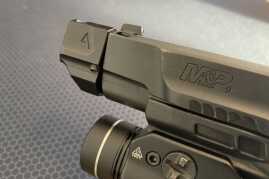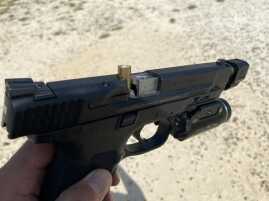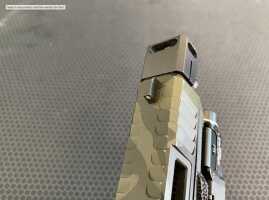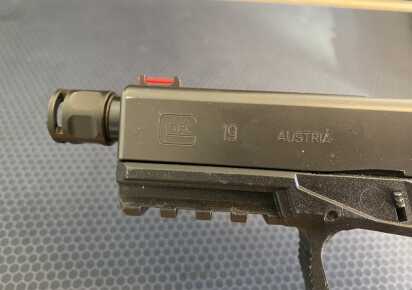
A Quick Introduction to Compensators
Before you start commenting “What kind of sissy needs a compensator for such a puny round like 9MM” –because I know at least five of you are thinking it.…let’s talk about what compensators do and who they’re designed for.
A compensator usually fits over your threaded barrel, secured by set screw, clamps, or some other mechanism to prevent it from rotating off the threads. The compensator is outfitted with ports or exit points for gas to travel as the bullet leaves the barrel. These ports allow gas to escape putting downward pressure on the muzzle keeping it flatter. The more ports available the more downward pressure from escaping gas and less muzzle rise. The added weight of the compensator also aids in keeping your muzzle down.

Now 9MM doesn’t pack that much of a punch and recoil can be managed with a reasonable amount of practice so why would anyone use a compensator?
While I don’t think compensators are a must have accessory they certainly do help manage recoil and muzzle rise and there are 2 classes of people where this matters:
- New and often young shooters who may not be accustomed to centerfire pistol cartridges
- Competitive shooters looking to decrease splits
Compensators objectively make a difference in recoil management and controlling muzzle rise. Reducing recoil helps you stay on target and make subsequent follow-up shots faster. It also makes controlling the gun easier in the hands of a new shooter.
Sometimes a compensator can funnel out too-much gas and make cycling an issue necessitating the use of a lighter recoil guide rod to get reliable cycling out of a factory pistol. Curious, I wanted to test 3 well-known compensator brands and 1 lesser-known brand.
Let’s dive into the test set-up and results.
Testing Parameters
There are hundreds of compensators available to consumers. From goofy AliExpress comps that cost $20 all the way up to the higher end of the spectrum over $100. I’ve heard good things about several different brands and noticed folks at local sandlot matches using Agency’s 118 (M&P) or 417 (Glock) as well as the Griffin Armament Micro-Carry compensator.
Curious what the big deal was, I ponied up and bought the following compensators for testing:
- Agency 118 for the M&P pistol series – $110
- Killer Innovations Velocity for the CZ-P10c – $118
- Griffin Armament Micro-Carry for any 9MM pistol – $70
- KT Crafts Glock 17/19 Carry compensator – $36
The first 3 are pretty common but the KT Crafts compensator is from a small shop that sells their compensators on eBay. I met the owner thru Gun Twitter while I was planning this test and decided to test his comps against some of the better known brands. All compensators were bought and paid for by me in the name of science.
With this test I’ll be taking a look at a few different dimensions in testing so I’ll outline the parameters below.

First, I had budgeted for about 400 rounds per compensator spread out across a few different range days. Due to the cost of ammo, I would only allow 4 cycling malfunctions before failing the test. If there was a structural failure catastrophic or not, i.e. the compensator walked off a threaded barrel …. it would be an automatic disqualification.
The object is to assess performance across 4 core parameters:
- My subjective rating of recoil reduction
- # of elapsed rounds before a malfunction
- Total count of malfunctions
- Price
Additionally, I did not swap out recoil guide rods to accommodate for the change in recoil to assist cycling. None of these brands make explicit guarantees that you’ll need a lighter guide rod so I want to see how they performed against an OEM configuration.
One Compensator Failed the Test
Needless to say, there was one compensator that completely failed my test: The Agency 110 for the Smith & Wesson M&P series of pistols. I attached it to my M&P 2.0 also equipped with a 5″ Agency threaded barrel.
I experienced 3 stovepipes within the first 28 rounds. Furthermore, the Agency 118 failed due to walking off the threaded barrel but also experienced 3 stovepipes through the course of testing which equates to a 1.5% failure rate against this sample size. This is disappointing because the Agency 118 was the softest shooting of the group but that came at the expense of reliability. I suspect using a lighter recoil guide rod will resolve this problem but I want to test this using mostly OEM parts (aside from barrels).



Test Results
| Compensator | Price | Subjective Recoil Reduction Rating | Rounds Tested | Malfunctions | Malfunction Rate | Round Count Before First Malfunction |
| Agency 110 M&P Comp | $110 | 25% | 200 | 3 | 1.5% | 28 |
| KT Crafts MN | $36 | 15% | 400+ | 0 | 0.0% | N/A |
| Killer Innovations Velocity Comp | $118 | 20% | 400 | 2 | 0.5% | 42 |
| Griffin Armament Micro Carry Comp | $65 | 10% | 400 | 0 | 0.0% | N/A |
I’m focusing on 2 criteria here for which performed the best: recoil reduction and absence of malfunctions. It doesn’t matter much to me if you can reduce recoil by 30% if the pistol won’t cycle so I’m willing to trade off more recoil for better performance.
That being said, there are two clear winners: The KT Crafts single-port Glock compensator and the Griffin Armament Micro-Carry. Both reduced recoil by what I would estimate to be 10-15% and experienced zero malfunctions.


Machined from 6062 aluminum and tightened to the barrel using the included socket head cap screws at 10-12 inch pounds, the KT Crafts Micro Carry has continued to perform beyond the 400 round test as I’ve added them to a few other pistols I keep in rotation. While it doesn’t reduce recoil quite as much as the Agency 118 or KI Velocity, it ran flawlessly while still making a noticeable improvement in recoil reduction. A trade-off I’m more than happy to make. It has a low-profile, matching the slide dimensions and I had no issues using a Black Rhino Concealment holster with this.


Coming in second place is the Griffin Armament Micro-Carry compensator. Out of all that were tested, this one had the least noticeable difference in recoil- however, it performed flawlessly. Its compact profile makes holster compatibility a non-issue. Griffin Armament is a well-respected name in the firearms community and if it weren’t for being priced 2x higher and reducing felt muzzle flip slightly less than KT Crafts… it could’ve been the winner.


Third place goes to the KI Velocity CZ P10c compensator. I experienced 2 stovepipes in the first 2 magazines with this one but had no issues. If not for those two malfunctions, this would be the winner as it had a substantial improvement in reducing muzzle rise. However, it’s almost 2x the price of compensators from Griffin Armament Micro-Carry and more than 3x the price of the KT Crafts offering.
I won’t lie. I had high hopes for the KI Velocity comp. It looked the coolest and it was the most expensive but sometimes price doesn’t always equal performance. However, I will caveat that by saying the KI Velocity has performed flawlessly well past the 400 round test and I’m willing to chalk those early stovepipes up to a break-in period.
Conclusions
Compensators certainly aren’t for everyone and fill a niche need. I don’t have a problem shooting without one but they undeniably make a difference in managing recoil. Whether you’re introducing a new shooter to centerfire pistol rounds or looking to reduce splits- I hope this review helps inform that decision.

Personally I wouldn’t start a new shooter on a center fire pistol. Rim fire is the way to go with new shooters. I like the idea of pistol comps but have yet to see any that reduce recoil enough to justify the purchase price. Just my opinion.
What added noise or blast was there for the chooser and others by the side?